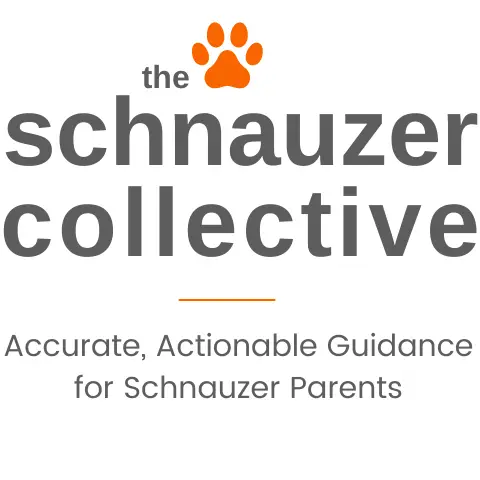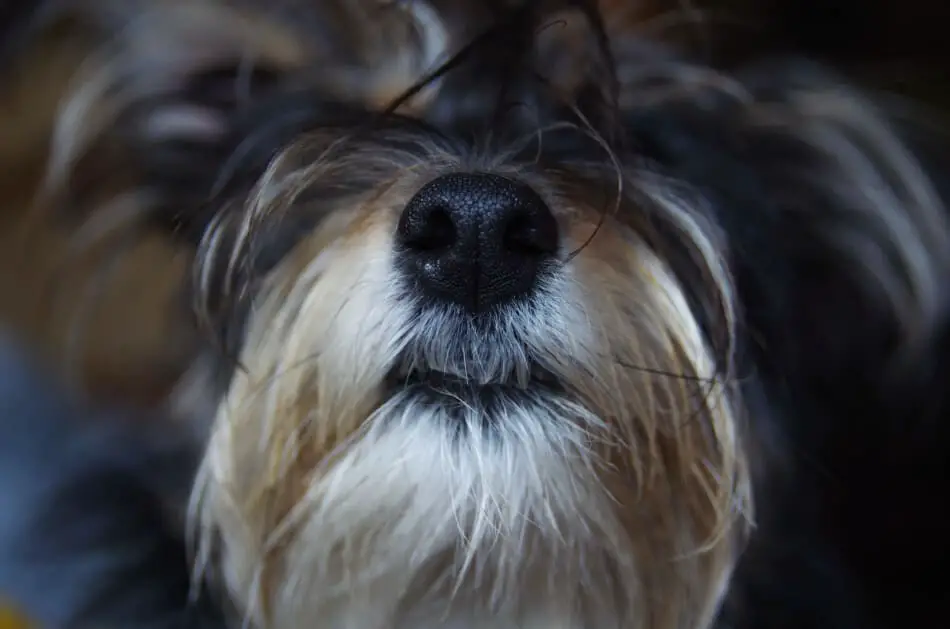Cats aren’t the only fur friends who might suffer from hairballs. Believe it or not, dogs can accumulate enough hair and other non-digestible debris to form hairballs. Since our Miniature Schnauzer, Livi, coughs oddly from time to time and seems like she is trying to expel something, I did some deeper research into the possibility of hairballs. This article covers what all Schnauzer parents need to know.
Hairballs in Schnauzers are considered rare, but can develop under some conditions. If your Schnauzer’s hair is longer, the chances increase. Overdone self-grooming due to behavioral compulsions or allergies can also lead to the ingestion of hair. In addition, a Schnauzer with itchy skin or parasites such as ticks and fleas is more likely to chew at, and potentially ingest, hair.
When the formation of a hairball starts, further ingestion can create a snowball ball effect, making the hairball larger with time.
If the hairball becomes too large, it will be clearly become uncomfortable for your Schnauzer.
Hairballs can also start to ferment, and the physical discomfort might compel him to vomit or attempt to cough the hairball out. If the hairball becomes lodged, it can cause a blockage in his digestive tract.
Even thought this situation is not very common, it can definitely happen. Let’s look at the formation of hairballs, how to recognize the signs, and what to do.
What Exactly are Hairballs and How are They Created?
Understanding exactly what hairballs are and how they are created will help you stay alert to your Schnauzuer’s behavior, his environment, and any signs of problems.
What are Hairballs?
Hairballs, also known as trichobezoars or tricholiths refer to a mass of accumulated hair material surrounding non-digestible items that get stuck in the esophagus, intestines, or the stomach.
Hairballs come in various shapes ranging from tabular to rounded, to spherical. Depending on how often your Schnauzer coughs them up, they can be a dry, wet, or a soggy mass.
How are Hairballs Created?
As with cats, hairballs consist primarily of your Schnauzer’s coat hair and might periodically contain other forms of fibers like grass and other non-soluble material.
Schnauzers ingest their hair by grooming and licking. They can also ingest hair from their surroundings, such as bedding, furniture, floors, and carpet.
“Hairballs in Schnauzers are considered rare, but can develop under some conditions. If your Schnauzer’s hair is longer, the chances increase.”
THE SCHNAUZER COLLECTIVE
Can Schnauzers Eliminate a Hairball? (Either through Coughing or Pooping?)
Hairballs can pose different risks based on how many there are, how large they have become, and how long the materials have been in the gastrointestinal tract.
Generally speaking, your Schnauzer can easily eliminate small amounts of fur that he ingests, especially if they are small and his bowel elimination speed is normal.
However, if he has a slow elimination rate, he can develop hairball issues even if he swallows the fur in small amounts. When the fur accumulates in the stomach, they entangle each other, creating an almost solid mass.
If your Schnauzer has a weak body system, he might have problems coughing it out, vomiting it up, or eliminating it through his digestive track and bowel movements.
If your Schnauzer is having trouble, look for the 5 signs below.
5 Signs Your Schnauzer Has a Hairball
Hairballs in Schnauzers are thankfully rare and preventable. By understanding the associated signs, you can easily reduce your Schnauzer’s chances of suffering from the various uncomfortable symptoms of hairballs.

Here are some of the signs that indicate your Schnauzer has developed hairballs.
Sign #1: Coughing and Gagging
Gagging is usually a normal reflex that is caused some stomach contractions. It is the tummy’s attempt to expel an object that’s blocking the digestive area.
Coughing is essentially a protective action to clear your Schnauzer’s airways. When your Schnauzer is able to eject hairballs by coughing and gagging, it’s not much to worry about.
However, excessive gagging and coughing indicate that your Schnauzer is in extreme distress and needs your attention. If he can’t expel the hairball, please seek immediate medical attention.
Sign #2: Constipation and Diarrhea
Hairballs can cause blockages in the digestive system if they are not ejected through vomiting and coughing.
Bouts of constipation and diarrhea can indicate that your Schnauzer is unable to pass something in his digestive track…possibly a hairball. This can happen when the hairballs are too solid and large to pass with the feces.
Most Schnauzers excrete feces between one and five times each day. If your Schnauzer has constipation, he may try to pass stool without success several times. He might circle excessively, squat regularly, or drag his bottom along the ground as if to pass feces. Other symptoms include passing watery stool in small amounts along with a decreased appetite.
Sign #3: Decreased Appetite
Your Schnauzer’s interest in food may change from time to time. However, they generally have a strong appetite and will be eager to eat twice each day.
Many health and stressors can lead to a decreased appetite or lack of interest in his food. However, rejecting food for a prolonged time might be an indication that something is not right. If your Schnauzer refuses to take a proper meal for over 48 hours, it would be best to consult your veterinarian for advice.
Large, hardened hairballs can lead to abdominal discomfort and nausea in your Schnauzer. These symptoms can lead to decreased or loss of appetite.
Sign #4: Dry and Itchy Skin
Dry and itchy skin is both a potential cause and sign of hairballs.
Dry skin is not only uncomfortable for your Schnauzer, but it might also be an indication of hairball formations. One of the most common signs of dry skin issues is itchiness. Your Schnauzer will scratch and lick himself to relieve the discomfort he is experiencing. He may also rub against your furniture to eliminate the itchiness. The other signs of dry skin may include scaly or flaky skin and hair loss.
The main issue here is constant licking. As your Schnauzer licks his skin to relieve the symptoms, he unintentionally ingests hair. The hair may accumulate in the stomach over time, possibly resulting in a hairball.
Sign #5: Excessive Grooming or Licking
Excessive grooming and licking are both potential causes and signs of hairballs.
Excessive grooming or licking is generally how the formation of hairballs starts. Your Schnauzer might be over-grooming due to various physiological reasons such as food allergies, ectoparasites, pyodermas, atopic dermatitis, and flea hypersensitivity. Also, psychogenic factors can lead to increased grooming. Some of these factors include separation anxiety, depression, generalized anxiety, extreme boredom, and obsessive-compulsive disorder.
5 Ways to Treat a Hairball
In most cases, you can manage hairballs at home. If you suspect that your Schnauzer has a hairball, you can offer canned pumpkin, petroleum jelly, and enough water to assist him in ejecting them.

Let’s look at how these home remedies work, along with other available treatments you might need.
- Pumpkin. Pumpkins are known to contain huge amounts of fiber, which can help pull out the hairballs as they pass via the gastrointestinal tract. Apart from that, they can help support the tract’s mucus membranes, allowing it to travel smoothly in the stomach.
- Petroleum Jelly. Offering your Schnauzer petroleum jelly can assist in smoothening out the hairball’s passage either through your Schnauzer’s stomach or throat. It can also help soften the hairball if it has a big quantity of hair. Clearly, the taste and texture might be off-putting to your Schnauzer.
- Hairball Treatment. You can also offer a petroleum-based commercial hairball treatment. Even if the treatments are created primarily for cats, they are safe for dogs as well.
- Laxatives. Laxatives can be quite effective in the treatment of hairballs. However, they can cause uncomfortable diarrhea and painful cramping in your Schnauzer. Use this treatment under the guidance and supervision of your veterinarian. The dosage and type of laxatives used will depend on the health and age of your Schnauzer.
- Surgery. If the hairballs are large, stiff, or too hard to be ejected via the anus, a surgical procedure will be needed. Lodged hairballs are no laughing matter and must be addressed immediately. Unresolved situations can be fatal.
5 Ways To Prevent Hairballs
It’s not always possible to prevent your Schnauzer from developing hairballs. However, just knowing that dogs can form hairballs is a beginning.
Keeping an eye on his environment and watching for any worrisome signs is a next step.

In addition, here are several effective ways you can help your Schnauzer avoid the pain and possible complications of hairballs.
- Coat Trimming. Occasional trimming reduces the chances of hairball formation. Once your Schnauzer’s hair is trimmed correctly, it becomes easy to groom him. When he is well-groomed, you can get rid of loose hairs quickly and easily. In other words, proper grooming is a very effective way to prevent hairballs.
- Brushing. Brushing helps significantly in the prevention of hairballs. Even though Schnauzers shed very little, brushing is essential to help get rid of the dead fur, dander, and dust before your Schnauzer ingests his hair. Consider brushing not only for grooming time, but also as a means to massage and bond with your Schnauzer. A brushing mitt is a great option, and we use this specific mitt for our Livi.
- Proper Feeding. Feed your Schnauzer nutritious food appropriate to his age and any health problems. When fed with the right nutrients, his health and coat will be strong. Proper nutrition can keep his coat softer and shinier. More importantly, it can reduce skin issues and allergies that can lead to excessive licking.
- Parasite Control. Parasites sucn as ticks and fleas cause a lot of discomfort and lead to itching, biting, and licking….all of which can lead to hairballs. Keep up on flea and tick treatments.
- Keeping Your Schnauzer Happy and Busy. Schnauzers are highly intelligent and you may want to read my article Are Schnauzers Smart? (How to Tell and 5 At-Home Tests) for details. Such an intelligent breed tends to become bored, and possibly even depressed, easily. Bored Schnauzers can become destructive to your home or to themselves. A happy, engaged, and well-exercised Schnauzer is less likely to lick, bite, or over-groom himself.
And finally, from one pet parent to another, discover my all-time favorite resources designed to cover your every Schnauzer need. I’ve done the legwork for you so you can spend more time with the people and fur friends in your life.
A portion of all profit earned on this site is donated to Pet Partners
whose mission is to improve human health and
well-being through the human-animal bond.
They train and register pets to become therapy animals,
and have local chapters in many states.

